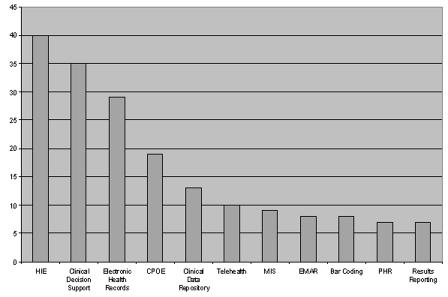Abstract
A major agenda item of the President and Congress is widespread adoption of health information technology (health IT) to improve the quality, safety, and efficiency of health care. This has allowed federal agencies to invest additional money into health IT research. The distribution and potential impact of research dollars spent by one agency supporting this agenda is examined here.
Introduction
Since September 2004, the Agency for Healthcare Research and Quality (AHRQ) has invested over $166 million in more than 40 states for health information technology implementation and research projects.1 The goal of AHRQ’s investment is to improve patient safety and quality of care through the successful adoption and use of health information technologies.
The AHRQ National Resource Center for Health IT (NRC) was created to help the nation embrace the power and efficiency of health IT. The NRC provides information and resources to the Agency, AHRQ grants and contracts, other federal agencies and the nation at-large, primarily though its web site (http://healthit.ahrq.gov).
Methods
To understand the impact of AHRQ’s investment, researchers from the NRC examined the characteristics of each active AHRQ health IT portfolio grant and contract as of January 1, 2006. The researchers classified each project on three dimensions: (1) the communities (e.g., rural, urban) in which technology is being deployed or evaluated, (2) the care settings (e.g., inpatient, ambulatory) in which technology is being deployed or evaluated, and (3) what technologies (e.g., health information exchange, computerized physician order entry) are being deployed or evaluated.
After the researchers finished classifying the grants and contracts, the classifications were reviewed by NRC faculty members who provide support to the projects and possess a deep understanding of the field of health IT.
Results
Of the 87 active projects reviewed, 57 (65.5%) involve deployment or evaluation of health IT in rural areas, where known health IT adoption rates are significantly lower than comparable urban areas.2
The most significant care setting in the portfolio is ambulatory (72.4%), followed by inpatient (56.3%), emergency (18.4%), and community health centers (14.9%).
There are more than 16 unique technologies across the portfolio. Figure 1 shows the distribution of the top eleven. Forty (46.0%) projects involve technology designed to exchange health information among disparate systems. Other significant technologies include clinical decision support (40.2%), electronic health records (33.3%), and computerized physician order entry (21.8%).
Figure 1:
Distribution of significant technologies
Conclusion
AHRQ’s portfolio of health IT projects is diverse, with projects engaged in the development and evaluation of a wide range of technologies. The majority of projects target clinical settings and communities where a majority of Americans receive their health care.
For these reasons, the NRC believes the potential impact of these projects on the field to be significant. The NRC intends to monitor these projects over time to synthesize best practices and findings for replication in health care organizations across the nation.
References
- 1.The Agency for Healthcare Research and Quality (AHRQ) Health Information Technology Programs - Update 2005–06. Publication No. 06-P009, 2006. [Google Scholar]
- 2.Fonkych K, Taylor R. The State and Pattern of Health Information Technology Adoption. Santa Monica, Calif: RAND; 2005. [Google Scholar]



